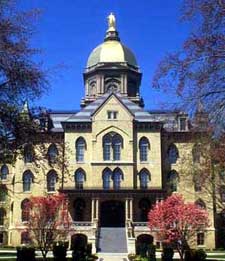Main Content
Article
High Victorian Gothic Style

Notre Dame University Administration Building
South Bend, IN
Features to Look For:
- Use of Gothic forms; pointed arches, tracery, grouped colonettes
- Heavy stone and brick work, polychromy (contrasting colors)
- Bold forms; towers, massive hip and gabled roofs
- Larger scale than Early Gothic buildings
Unlike the Early Gothic Revival, the High Victorian Gothic style was mainly inspired by Venetian Gothic architecture rather than English Medieval buildings. English architectural critic John Ruskin was an important figure in advocating the style.
Many of the characteristics of early Gothic Revival apply to this style. In contrast to the use of delicate applied wood ornamentation of the earlier movement, architects of the High Victorian Gothic style favored heavy, structural detailing. Buildings of the style are usually irregularly shaped and nearly always of masonry construction. Even the colors of materials were supposed to evoke the sense of craftsmanship associated with medieval buildings. The style was short lived in popularity, lasting only from about 1875 to 1885 in Indiana.
Examples of High Victorian Gothic StyleClick to enlarge

Nicholson-Rand House
Indianapolis, Marion County
Photo - 2003

Beech Grove Cemetery Gate
Muncie, Delaware County
Photo - 1997

Notre Dame University Administration Building
South Bend, Saint Joseph County
Photo courtesy of Notre Dame Univ.
